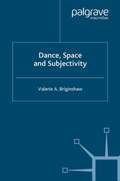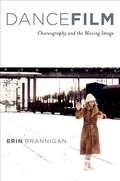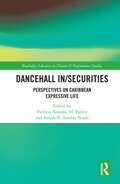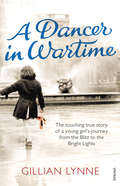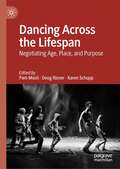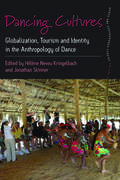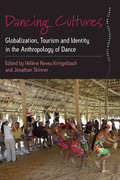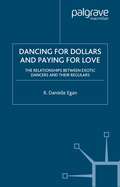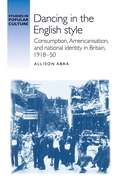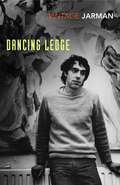- Table View
- List View
Dance on Screen: Genres and Media from Hollywood to Experimental Art
by S. DoddsDance on Screen is a comprehensive introduction to the rich diversity of screen dance genres. It provides a contextual overview of dance in the screen media and analyzes a selection of case studies from the popular dance imagery of music video and Hollywood, through to experimental art dance. The focus then turns to video dance, dance originally choreographed for the camera. Video dance can be seen as a hybrid in which the theoretical and aesthetic boundaries of dance and television are traversed and disrupted. This new paperback edition includes a new Preface by the author covering key developments since the hardback edition was published in 2001.
Dance Practices as Research: Approaches to the Safeguarding and Transmission of the Intangible Cultural Heritage of Dance (Heritage Studies)
by Vicky KämpfeThis book contributes to the growing scientific literature on ‘intangible cultural heritage’ – determined by UNESCO to be particularly worthy of safeguarding and transmission – by advancing a theoretical-analytical framework for the (in)tangible cultural heritage of dance. By exploring the potential of the ‘intangible materiality’ of dance practice the book argues that implementing the concept of a ‘performative dance-archive’ creates a new analytic field: research in praxis. The concept of the ‘performative dance-archive’ draws out the potential for safeguarding and transmission of dance heritage, but also the challenges of the opposition between living heritage and the codifying of cultural inventories. This book uses the formal and contextual transformation of Argentine tango and German modern dance to discuss this ambiguity of intangible heritage and how the “performative dance-archive” creates a cognitive, empractical approach to determine, archive, and distribute dance knowledge. This is a timely methodological intervention in the context of the increasing importance of the intangible cultural heritage. It enables us to re-revise the concept of (im)materiality and the specific knowledges within cultural practice as a necessary fundamental category for research-processes and societal growth. This book is directed both to researchers in the field of intangible cultural heritage and to practitioners and researchers searching for new ways of investigating methods and perspectives to understand 'immaterial materialities'.
Dance, Space and Subjectivity
by V. BriginshawThis book contains readings of American, British and European postmodern dances informed by feminist, postcolonialist, queer and poststructuralist theories. It explores the roles dance and space play in constructing subjectivity. By focusing on site-specific dance, the mutual construction of bodies and spaces, body-space interfaces and 'in-between spaces', the dances and dance films are read 'against the grain' to reveal their potential for troubling conventional notions of subjectivity associated with a white, Western, heterosexual able-bodied, male norm.
Dance Your Way Home: A Journey Through the Dancefloor
by Emma WarrenThis book is about the kind of ordinary dancing you and I might do in our kitchens when a favourite tune comes on. It's more than a social history: it's a set of interconnected histories of the overlooked places where dancing happens . . .Why do we dance together? What does dancing tells us about ourselves, individually and collectively? And what can it do for us? Whether it be at home, '80s club nights, Irish dancehalls or reggae dances, jungle raves or volunteer-run spaces and youth centres, Emma Warren has sought the answers to these questions her entire life. Dancing doesn't just refract the music and culture within which it evolves; it also generates new music and culture. When we speak only of the music, we lose part of the story - the part that finds us dancing as children on the toes of adults; the half that triggers communication across borders and languages; the part that finds us worried that we'll never be able to dance again, and the part that finds us wondering why we were ever nervous in the first place.At the intersection of memoir, social and cultural history, Dance Your Way Home is an intimate foray onto the dancefloor - wherever and whenever it may be - that speaks to the heart of what it is that makes us move.
Dancefilm: Choreography and the Moving Image
by Erin BranniganDancefilm: Choreography and the Moving Image examines the choreographic in cinema - the way choreographic elements inform cinematic operations in dancefilm. It traces the history of the form from some of its earliest manifestations in the silent film era, through the historic avant-garde, musicals and music videos to contemporary experimental short dancefilms. In so doing it also examines some of the most significant collaborations between dancers, choreographers, and filmmakers. The book also sets out to examine and rethink the parameters of dancefilm and thereby re-conceive the relations between dance and cinema. Dancefilm is understood as a modality that challenges familiar models of cinematic motion through its relation to the body, movement and time, instigating new categories of filmic performance and creating spectatorial experiences that are grounded in the somatic. Drawing on debates in both film theory (in particular ideas of gesture, the close up, and affect) and dance theory (concepts such as radical phrasing, the gestural anacrusis and somatic intelligence) and bringing these two fields into dialogue, the book argues that the combination of dance and film produces cine-choreographic practices that are specific to the dancefilm form. The book thus presents new models of cinematic movement that are both historically informed and thoroughly interdisciplinary.
Dancefilm: Choreography and the Moving Image
by Erin BranniganDancefilm: Choreography and the Moving Image examines the choreographic in cinema - the way choreographic elements inform cinematic operations in dancefilm. It traces the history of the form from some of its earliest manifestations in the silent film era, through the historic avant-garde, musicals and music videos to contemporary experimental short dancefilms. In so doing it also examines some of the most significant collaborations between dancers, choreographers, and filmmakers. The book also sets out to examine and rethink the parameters of dancefilm and thereby re-conceive the relations between dance and cinema. Dancefilm is understood as a modality that challenges familiar models of cinematic motion through its relation to the body, movement and time, instigating new categories of filmic performance and creating spectatorial experiences that are grounded in the somatic. Drawing on debates in both film theory (in particular ideas of gesture, the close up, and affect) and dance theory (concepts such as radical phrasing, the gestural anacrusis and somatic intelligence) and bringing these two fields into dialogue, the book argues that the combination of dance and film produces cine-choreographic practices that are specific to the dancefilm form. The book thus presents new models of cinematic movement that are both historically informed and thoroughly interdisciplinary.
Dancehall In/Securities: Perspectives on Caribbean Expressive Life (Routledge Advances in Theatre & Performance Studies)
by Patricia Noxolo H Patten Sonjah N. Stanley NiaahThis book focuses on how in/security works in and through Jamaican dancehall, and on the insights that Jamaican dancehall offers for the global study of in/security. This collection draws together a multi-disciplinary range of key scholars in in/security and dancehall. Scholars from the University of the West Indies' Institute of Caribbean Studies and Reggae Studies Unit, as well as independent dancehall and dance practitioners from Kingston, and writers from the UK, US and continental Europe offer their differently situated perspectives on dancehall, its histories, spatial patterning, professional status and aesthetics. The study brings together critical security studies with dancehall studies and will be of great interest to students, scholars and practitioners in theatre, dance and performance studies, sociology, cultural geography, anthropology, postcolonial studies, diaspora studies, musicology and gender studies.
Dancehall In/Securities: Perspectives on Caribbean Expressive Life (Routledge Advances in Theatre & Performance Studies)
by Patricia Noxolo ‘h’ Patten Sonjah N. Stanley NiaahThis book focuses on how in/security works in and through Jamaican dancehall, and on the insights that Jamaican dancehall offers for the global study of in/security. This collection draws together a multi-disciplinary range of key scholars in in/security and dancehall. Scholars from the University of the West Indies' Institute of Caribbean Studies and Reggae Studies Unit, as well as independent dancehall and dance practitioners from Kingston, and writers from the UK, US and continental Europe offer their differently situated perspectives on dancehall, its histories, spatial patterning, professional status and aesthetics. The study brings together critical security studies with dancehall studies and will be of great interest to students, scholars and practitioners in theatre, dance and performance studies, sociology, cultural geography, anthropology, postcolonial studies, diaspora studies, musicology and gender studies.
A Dancer in Wartime: The touching true story of a young girl's journey from the Blitz to the Bright Lights
by Gillian LynneLondon during the Blitz was a time of hardship, heroism and hope.For Gillian Lynne – a budding ballerina – it was also a time of great change as she was evacuated from war-torn London to a crumbling mansion, where dance classes took place in the faded ballroom.Life was hard, but her talent and dedication shone through and an astonishing journey ensued, which saw Gillian dancing a triumphant debut in Swan Lake, performing in the West End with doodlebugs falling and touring a devastated Europe entertaining the troops.A Dancer in Wartime paints a vivid and moving picture of what life was really like during the hard years of the Blitz and brings to life a lost world.
Dancers on the Shore (Howard University Press Library Of Contemporary Literature #No. 13)
by William Melvin Kelley'There is no need of prophesying that Mr. Kelley will one day be among the best American short story writers. Dancers on the Shore proves that he already is' New York Herald TribuneIn 1964, two years after the critically lauded release of his debut novel A Different Drummer, William Melvin Kelley published his first collection of short stories, Dancers on the Shore. Reissued in a new edition by riverrun, these seventeen stories expand Kelley's literary world, showcase his limitless imagination and spotlight his inimitable talent.
Dances with Sheep: The Quest for Identity in the Fiction of Murakami Haruki (Michigan Monograph Series in Japanese Studies #37)
by Matthew Carl StrecherAs a spokesman for disaffected youth of the post-1960s, Murakami Haruki has become one of the most important voices in contemporary Japanese literature, and he has gained a following in the United States through translations of his works. In Dances with Sheep, Matthew Strecher examines Murakami’s fiction—and, to a lesser extent, his nonfiction—for its most prevalent structures and themes. Strecher also delves into the paradoxes in Murakami’s writings that confront critics and casual readers alike. Murakami writes of “serious” themes yet expresses them in a relatively uncomplicated style that appeals to high school students as well as scholars; and his fictional work appears to celebrate the pastiche of postmodern expression, yet he rejects the effects of the postmodern on contemporary culture as dangerous. Strecher’s methodology is both historical and cultural as he utilizes four distinct yet interwoven approaches to analyze Murakami’s major works: the writer’s “formulaic” structure with serious themes; his play with magical realism; the intense psychological underpinnings of his literary landscape; and his critique of language and its capacity to represent realities, past and present. Dances with Sheep links each of these approaches with Murakami’s critical focus on the fate of individual identity in contemporary Japan. The result is that the simplicity of the Murakami hero, marked by lethargy and nostalgia, emerges as emblematic of contemporary humankind, bereft of identity, direction, and meaning. Murakami’s fiction is reconstructed in Dances with Sheep as a warning against the dehumanizing effects of late-model capitalism, the homogenization of the marketplace, and the elimination of effective counterculture in Japan.
Dances with Spiders: Crisis, Celebrity and Celebration in Southern Italy (Epistemologies of Healing #4)
by Karen LüdtkeFor centuries, the rite of the tarantula was the only cure for those ‘bitten’ or ‘possessed’ by the mythic Apulian spider. Its victims had to dance to the local tarantella or ‘pizzica’ for days on end. Today, the pizzica has returned to the limelight, bringing to the forefront issues of performance, gender, identity and well-being. This book explores how and why the pizzica has boomed in the Salento and elsewhere and asks whether this current popu- larity has anything to do with the historic ritual of tarantism or with the intention of recovering well-being. While personal stories and experiences may confirm the latter, a vital shift has appeared in the Salento: from the confrontation of life crises to the vibrant promotion and celebration of a local sense of identity and celebrity.
Dancing Across the Lifespan: Negotiating Age, Place, and Purpose
by Karen Schupp Doug Risner Pam MusilThis book critically examines matters of age and aging in relation to dance. As a novel collection of diverse authors’ voices, this edited book traverses the human lifespan from early childhood to death as it negotiates a breadth of dance experiences and contexts. The conversations ignited within each chapter invite readers to interrogate current disciplinary attitudes and dominant assumptions and serve as catalysts for changing and evolving long entrenched views among dancers regarding matters of age and aging.The text is organized in three sections, each representing a specific context within which dance exists. Section titles include educational contexts, social and cultural contexts, and artistic contexts. Within these broad categories, each contributor’s milieu of lived experiences illuminate age-related factors and their many intersections. While several contributing authors address and problematize the phenomenon of aging in mid-life and beyond, other authors tackle important issues that impact young dancers and dance professionals.
Dancing at the Shame Prom: Sharing the Stories That Kept Us Small
by Amy Ferris Hollye DexterShame is a powerful thing. It can weigh on your heart and mind, diminish your sense of self-worth, and impact the way you live in the world. But what happens when you share that secret burden?Amy Ferris, Hollye Dexter, and the writers they brought together are all ready to let go of shame. In Dancing at the Shame Prom, twenty-six extraordinary women-Lyena Strelkoff, Teresa Stack, Monica Holloway, Nina Burleigh, Amy Friedman, Meredith Resnick, Victoria Zackheim, and more-take the plunge and say "yes” to sharing their stories. These brave writers, journalists, musicians, artists, directors, and activists have offered up their most funny, sad, poignant, miraculous, life-changing, and jaw-dropping secrets for you to gawk at, empathize with, and learn from-in the hopes that they will inspire others to do the same. Letting go feels good!Freeing, provocative, and audacious, Dancing at the Shame Prom is about flaunting the secrets that have made you feel small so that you can stand up straight, let the shame go, and finally-decisively-move on with your life.
Dancing Black, Dancing White: Rock 'n' Roll, Race, and Youth Culture of the 1950s and Early 1960s
by Julie MalnigDancing Black, Dancing White: Rock 'n' Roll, Race, and Youth Culture of the 1950s and Early 1960s offers a new look at the highly popular phenomenon of the televised teen dance program. These teen shows were incubators of new styles of social and popular dance and both reflected and shaped pressing social issues of the day. Often referred to as "dance parties," the televised teen dance shows helped cultivate a nascent youth culture in the post-World War II era. The youth culture depicted on the shows, however, was primarily white. Black teenagers certainly had a youth culture of their own, but the injustice was glaring: Black culture was not always in evident display on the airwaves, as television, like the nation at large, was deeply segregated and appealed to a primarily white, homogenous audience. The crux of the book, then, is twofold: to explore how social and popular dance styles were created and disseminated within the new technology of television and to investigate how the shows both reflected and re-affirmed the racial politics and attitudes of the time. The 1950s was a watershed decade for American culture and dance. The era witnessed the ascendancy of rock and roll music and recorded sound, the rise of the teenager as a marketing demographic, the beginnings of television, and a new phase of the country's struggle with race. The story of televised teen dance told here is about Black and white teenagers wanting to dance to rock 'n' roll music despite the barriers placed on their ability to do so. It is also a story that fuses issues of race, morality, and sexuality. Dancing Black, Dancing White weaves together these elements to tell two stories: that of the different experiences of Black and white adolescents and their desires to have a space of their own where they could be seen, heard, appreciated, and understood.
Dancing Black, Dancing White: Rock 'n' Roll, Race, and Youth Culture of the 1950s and Early 1960s
by Julie MalnigDancing Black, Dancing White: Rock 'n' Roll, Race, and Youth Culture of the 1950s and Early 1960s offers a new look at the highly popular phenomenon of the televised teen dance program. These teen shows were incubators of new styles of social and popular dance and both reflected and shaped pressing social issues of the day. Often referred to as "dance parties," the televised teen dance shows helped cultivate a nascent youth culture in the post-World War II era. The youth culture depicted on the shows, however, was primarily white. Black teenagers certainly had a youth culture of their own, but the injustice was glaring: Black culture was not always in evident display on the airwaves, as television, like the nation at large, was deeply segregated and appealed to a primarily white, homogenous audience. The crux of the book, then, is twofold: to explore how social and popular dance styles were created and disseminated within the new technology of television and to investigate how the shows both reflected and re-affirmed the racial politics and attitudes of the time. The 1950s was a watershed decade for American culture and dance. The era witnessed the ascendancy of rock and roll music and recorded sound, the rise of the teenager as a marketing demographic, the beginnings of television, and a new phase of the country's struggle with race. The story of televised teen dance told here is about Black and white teenagers wanting to dance to rock 'n' roll music despite the barriers placed on their ability to do so. It is also a story that fuses issues of race, morality, and sexuality. Dancing Black, Dancing White weaves together these elements to tell two stories: that of the different experiences of Black and white adolescents and their desires to have a space of their own where they could be seen, heard, appreciated, and understood.
Dancing Communities: Performance, Difference and Connection in the Global City (Studies in International Performance)
by J. HameraDancers create 'civic culture' as performances for public consumption, but also as vernaculars connecting individuals who may have little in common. Examining performance and the construction of culturally diverse communities the book suggests that amateur and concert dance can teach us how to live and work productively together.
Dancing Cultures: Globalization, Tourism and Identity in the Anthropology of Dance (Dance and Performance Studies #4)
by Hélène Neveu Kringelbach  Jonathan SkinnerDance is more than an aesthetic of life – dance embodies life. This is evident from the social history of jive, the marketing of trans-national ballet, ritual healing dances in Italy or folk dances performed for tourists in Mexico, Panama and Canada. Dance often captures those essential dimensions of social life that cannot be easily put into words. What are the flows and movements of dance carried by migrants and tourists? How is dance used to shape nationalist ideology? What are the connections between dance and ethnicity, gender, health, globalization and nationalism, capitalism and post-colonialism? Through innovative and wide-ranging case studies, the contributors explore the central role dance plays in culture as leisure commodity, cultural heritage, cultural aesthetic or cathartic social movement.
Dancing Cultures: Globalization, Tourism and Identity in the Anthropology of Dance (Dance and Performance Studies #4)
by Hélène Neveu Kringelbach Jonathan SkinnerDance is more than an aesthetic of life – dance embodies life. This is evident from the social history of jive, the marketing of trans-national ballet, ritual healing dances in Italy or folk dances performed for tourists in Mexico, Panama and Canada. Dance often captures those essential dimensions of social life that cannot be easily put into words. What are the flows and movements of dance carried by migrants and tourists? How is dance used to shape nationalist ideology? What are the connections between dance and ethnicity, gender, health, globalization and nationalism, capitalism and post-colonialism? Through innovative and wide-ranging case studies, the contributors explore the central role dance plays in culture as leisure commodity, cultural heritage, cultural aesthetic or cathartic social movement.
Dancing for Dollars and Paying for Love: The Relationships between Exotic Dancers and their Regulars
by D. EganThis book takes an in-depth look at the relationships exotic dancers have with their regular customers, and explores the limits of using feminist theory to discuss sex work. This is an accessible, revealing, and new look at a perennially intriguing and divisive subject - ideal teaching material for undergraduate courses in a variety of fields.
Dancing in the English style: Consumption, Americanisation and national identity in Britain, 1918–50 (Studies in Popular Culture)
by Allison AbraDancing in the English style explores the development, experience, and cultural representation of popular dance in Britain from the end of the First World War to the early 1950s. It describes the rise of modern ballroom dancing as Britain's predominant popular style, as well as the opening of hundreds of affordable dancing schools and purpose-built dance halls. It focuses in particular on the relationship between the dance profession and dance hall industry and the consumers who formed the dancing public. Together these groups negotiated the creation of a 'national' dancing style, which constructed, circulated, and commodified ideas about national identity. At the same time, the book emphasizes the global, exploring the impact of international cultural products on national identity construction, the complexities of Americanisation, and Britain's place in a transnational system of production and consumption that forged the dances of the Jazz Age.
Dancing in the English style: Consumption, Americanisation and national identity in Britain, 1918–50 (Studies in Popular Culture)
by Allison AbraDancing in the English style explores the development, experience, and cultural representation of popular dance in Britain from the end of the First World War to the early 1950s. It describes the rise of modern ballroom dancing as Britain's predominant popular style, as well as the opening of hundreds of affordable dancing schools and purpose-built dance halls. It focuses in particular on the relationship between the dance profession and dance hall industry and the consumers who formed the dancing public. Together these groups negotiated the creation of a 'national' dancing style, which constructed, circulated, and commodified ideas about national identity. At the same time, the book emphasizes the global, exploring the impact of international cultural products on national identity construction, the complexities of Americanisation, and Britain's place in a transnational system of production and consumption that forged the dances of the Jazz Age.
Dancing in the World: Revealing Cultural Confluences (Routledge Series in Equity, Diversity, and Inclusion in Theatre and Performance)
by Sinclair Ogaga Emoghene Kathleen A. SpanosHow can we create more inclusive spaces in the field of dance? This book presents a framework for dance practitioners and researchers working in diverse dance cultures to navigate academia and the professional dance field. The framework is based on the idea of "cultural confluences," conjuring up an image of bodies of water meeting and flowing into and past one another, migrating through what they refer to as the mainstream and non-mainstream. These streams are fluid categories that are associated with power, privilege, and the ability (or inability) to absorb other cultural forms in shared dance spaces. In reflective interludes and dialogues, Emoghene and Spanos consider the effects of migration on their own individual experiences in dance to understand what it means to carry culture through the body in various spaces. Through an analysis of language, aesthetic values, spaces, creative processes, and archival research practices, the book offers a collaborative model for communicating the value that marginalized dance communities bring to the field. This book will be of great interest to students, scholars, and arts administrators in dance.
Dancing in the World: Revealing Cultural Confluences (Routledge Series in Equity, Diversity, and Inclusion in Theatre and Performance)
by Sinclair Ogaga Emoghene Kathleen A. SpanosHow can we create more inclusive spaces in the field of dance? This book presents a framework for dance practitioners and researchers working in diverse dance cultures to navigate academia and the professional dance field. The framework is based on the idea of "cultural confluences," conjuring up an image of bodies of water meeting and flowing into and past one another, migrating through what they refer to as the mainstream and non-mainstream. These streams are fluid categories that are associated with power, privilege, and the ability (or inability) to absorb other cultural forms in shared dance spaces. In reflective interludes and dialogues, Emoghene and Spanos consider the effects of migration on their own individual experiences in dance to understand what it means to carry culture through the body in various spaces. Through an analysis of language, aesthetic values, spaces, creative processes, and archival research practices, the book offers a collaborative model for communicating the value that marginalized dance communities bring to the field. This book will be of great interest to students, scholars, and arts administrators in dance.
Dancing Ledge: Journals vol. 1
by Derek Jarman'What started as a book on the frustration of funding led to the writing of an autobiography at forty... I had so little to do in the daylight hours, I stayed up late unbuttoning Levis in back rooms.'In 1984 at the age of 40, the polymath film-maker Derek Jarman began to write his journals. In the first of these diaries, Dancing Ledge, we see his origins as a young artist, written with Jarman's distinctive immediacy, curiosity, and candour. Behind-the-scenes of his first controversial films and stage designs, at glamorous launch parties with friends like David Hockney, Ossie Clarke and Patrick Proktor, to the trials of securing funding, Dancing Ledge is a coming-of-age memoir for all fledgling artists.Dancing Ledge also chronicles a unique time in British history, capturing gay nightlife from the end of the war to the beginning of the AIDS epidemic.


